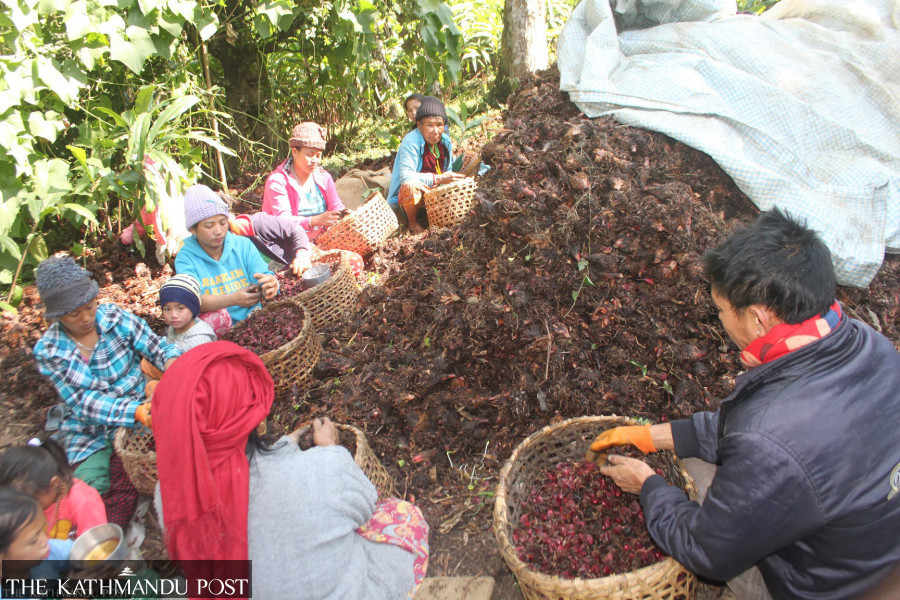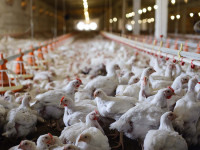Money
Large cardamom prices hit near-record levels
Prices surged to Rs2,500 per kg as global demand for the spice intensifies.
Post Report
Large cardamom prices have reached near-record levels, reaching Rs2,500 per kg in Monday’s trading.
The price of large cardamom reached a record high of Rs2,700 in 2014 but dropped to Rs850 in 2018, a dip of about 68 percent. The price again broke records in 2016, reaching an all-time high of Rs3,000 per kg. Prices then began to decline steadily, sinking to a low of Rs700 per kg in mid-July 2022.
Birtamod in Jhapa is the main trading hub for large or black cardamom, one of the world's most expensive spices.
Traders say that demand for the upcoming Ramadan, observed by Muslims worldwide, has been growing, which may trigger a fresh record in the coming days.
“As production has dropped in the major producing countries, demand has grown exuberantly in the global market,” said Nirmal Bhattarai, president of the Federation of Large Cardamom Exporters, Nepal. “We expect that large cardamom will hit a new record soon.”
Nepal is the largest producer of large cardamom, accounting for 68 percent of the global production, followed by India and Bhutan.
The spice is grown in Sikkim, Darjeeling and Bhutan. Large cardamom was introduced in Ilam from Sikkim in 1865.
The major cardamom-producing districts in Nepal include Ilam, Panchthar, Taplejung, Sankhuwasabha, Tehrathum, Bhojpur, and Dhankuta.
October- November is the peak harvest season.
“We expect production could drop by 25 percent in Nepal due to climate change-induced disease,” said Bhattarai. “The disease has affected old and new saplings of large cardamom in the last two years,” he said.
“Large cardamom growers cleared their stock last year as the price reached Rs2,150 per kg in the domestic market due to the fall in production. With no stock remaining and production sharply down, demand for the spice could push prices above Rs3,000 per kg in the local market,” said Bhattarai.
India is the biggest buyer of Nepal’s large cardamom, absorbing 99 percent of its exports. The spice is re-exported to Pakistan and the Middle East, where it fetches high prices because of local preference for Nepali products.
Pakistan is the largest importer of large cardamom, purchasing roughly 60 percent of India’s large cardamom exports. The local Muslim community uses large cardamom pods in biryani, a popular Pakistani dish, as a symbol of prosperity and wealth.
Large cardamom has three types depending on quality.
The ‘jumbo jet’ is the largest and it is being traded at Rs2,500 per kg. The standard variety is being traded at Rs2,450 per kg, and the third, normal variety is trading at Rs2,375 per kg.
The large cardamom grown in Nepal, known as Alaichi, is one of the country’s largest export crops. It is a high-value cash crop and a key income source for farmers in eastern Nepal's mountains and hills.
According to the Department of Customs, Nepal exported 5,367 tonnes of large cardamom worth Rs4.81 billion in 2021-22. Export jumped sharply to 9,990 tonnes worth Rs8.27 billion in 2022-23.
The customs record shows exports dropped by 50 percent to 5,018 tonnes in the last fiscal year, 2023-24. In value, exports amounted to Rs7.94 billion.
According to the Agriculture Ministry statistics, Nepal produced 9,545 tonnes of large cardamom in 2019-20. Output dropped to 8,289 tonnes in 2020-21. In 2021-22, production rose slightly to 8,714 tonnes and over 10,000 tonnes in 2022-23.
Farmers are expanding the large cardamom acreage beyond the eastern hill districts. The spice is also being grown in Dadeldhura and Lamjung.
Large cardamom is grown on 18,000 hectares in Nepal. Domestic consumption of large cardamom, however, is minimal.
Nepali traders were also making efforts to export large cardamom to Bangladesh directly through the Kakarbhitta-Panitanki-Phulbari route as demand has increased there, traders said.
The 44-km route provides the shortest access to the Bangladeshi border point of Banglabandha for Nepal's trade with and through Bangladesh.
Nepali large cardamom or black cardamom has a distinct flavour profile due to a specific method of postharvest drying in bhattis (ovens), which explains the roasted smell and taste.
The smoky flavour would overwhelm a sweet cake or pudding, but in a spice rub for roasted meat or a full-flavoured stew, it imparts a smouldering depth no other spice can, according to experts.
In February 2021, the process of identifying and registering five species of large cardamom indigenous to Nepal formally began, paving the way for claiming ownership rights and patenting them internationally.




 13.12°C Kathmandu
13.12°C Kathmandu












%20(1).jpg&w=300&height=200)
